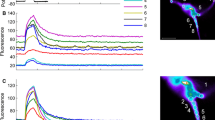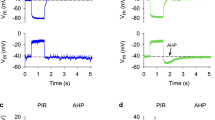Abstract
The origin of Ca2+ that activates the Ca2+-dependent K+ conductance which is responsible for the slow afterhyperpolarization (a.h.p.) following an action potential was studied in bullfrog sympathetic ganglia. The decay phase of the a.h.p. was a graded function of the extracellular Ca2+, and showed a voltage sensitivity opposite to that of the Ca2+-dependent K+-current reported previously (Pallotta et al. 1981), indicating that it reflected the time course of an increase in intracellular free Ca2+. An a.h.p. of longer duration was generated in cells which showed more pronounced rhythmic hyperpolarizations induced by intracellular Ca2+ release. The duration of the a.h.p. recorded with electrodes filled with K3-citrate [a.h.p. (citrate)], which favors Ca2+ release, was longer than the a.h.p. recorded with KCl-filled electrodes [a.h.p. (C1)]. D-600 (50–100 μM) drastically reduced the a.h.p. (C1), but had less effect on the a.h.p. (citrate). Caffeine which facilitates Ca2+ release prolonged the a.h.p. (C1), but had less effect on the a.h.p. (citrate). The a.h.p. (citrate) showed a greater sensitivity to a low temperature than the a.h.p. (C1). Mn2+ 91–3 mM) depressed both types of a.h.ps to the same extent. These results suggest that the origin of intracellular Ca2+ for a.h.p. (C1) is mainly Ca2+ influx during an action potential, while that for the a.h.p. (citrate) is both Ca2+ entry and intracellular Ca2+ release, although the effect of Mn2+ is difficult to explain fully.
Similar content being viewed by others
References
Adams PR (1981) The calcium current of a vertebrate neurone. In: Salánki J (ed) Physiol of excitable membranes. Adv Physiol Sci, vol 4. Pergamon Press, New York, pp 135–138
Adams PR, Constanti A, Brown DA, Clark RB (1982) Intracellular Ca2+ activates a fast voltage-sensitive K+ current in vertebrate sympathetic neurones. Nature (Lond) 296:746–749
Baker PF (1976) Regulation of intracellular Ca and Mg in squid axons. Fedn Proc 35:2589–2595
Barrett EF, Barrett JN (1976) Separation of two voltage-sensitive potassium currents, and demonstration of a tetrodotoxin-resistant calcium current in frog motoneurones. J Physiol (Lond) 255:737–774
Blackman JG, Ginsborg BL, Ray C (1963) Some effects of changes in ionic concentration on the action potential of sympathetic ganglion cells in the frog. J Physiol (Lond) 167:374–388
Blaustein MP, Ratzkaff RW, Kendrick NC, Schweitzer ES (1978) Calcium buffering in presynaptic nerve terminals. I. Evidence for involvement of a nonmitochondrial ATP-dependent sequestration mechanism. J Gen Physiol 72:15–41
Busis NA, Weight FF (1976) Spike after-hyperpolarization of a sympathetic neurone is calcium sensitive and is potentiated by theophylline. Nature (Lond) 263:434–436
Chiarandini DJ, Stefani E (1973) Effects of manganese on the electrical and mechanical properties of frog skeletal muscle fibres. J Physiol (Lond) 232:129–147
Endo M (1977) Calcium release from the sarcoplasmic reticulum. Physiol Rev 57:71–108
Fujimoto S, Yamamoto K, Kuba K, Morita K, Kato E (1980) Calcium localization in the sympathetic ganglion of the bullfrog and effects of caffeine. Brain Res 202:21–32
Gorman ALF, Thomas MV (1980) Potassium conductance and internal calcium accumulation in a molluscan neurone. J Physiol (Lond) 308:287–313
Kohlhardt M, Baner B, Krause H, Fleckenstein A (1972) New selective inhibitors of transmembrane Ca conductivity in mammalian myocardial fibres. Studied with the voltage clamp technique. Experientia 28:288–289
Koketsu K, Nishi S (1969) Calcium and action potential of bullfrog sympathetic ganglion cells. J Gen Physiol 53:608–623
Krnjević K, Lisiewicz A (1972) Injection of calcium ions into spinal motoneurones. J Physiol (Lond) 225:363–390
Kuba K (1980) Release of calcium ions linked to the activation of potassium conductance in a caffeine-treated sympathetic neurone. J Physiol (Lond) 298:251–269
Kuba K, Koketsu K (1976) Analysis of the slow excitatory postsynaptic potential in bullfrog sympathetic ganglion cells. Jpn J Physiol 26: 647–664
Kuba K, Koketsu K (1978) Intracellular injection of calcium ions and chelating agents into the bullfrog sympathetic ganglion cells and effects of caffeine. In: Ryall PW, Kelly JS (eds) Iontophoresis and transmitter mechanisms in the mammalian central nervous system. Elsevier/North-Holland Biomedical Press, Amsterdam New York, pp 158–160
Kuba K, Morita K (1980) The mechanism of the afterhyperpolarization of an action potential in bullfrog sympathetic ganglion cells. J Physiol Soc Jpn 42:32–33 (in Japanese)
Kuba K, Nishi S (1976) Rhythmic hyperpolarization and depolarization of sympathetic ganglion cells induced by caffeine. J Neurophysiol 39:547–563
Kuba K, Takeshita S (1981) Simulation of intracellular Ca2+ oscillation in a sympathetic neurone. J Theor Biol 93:1009–1031
Lux HD, Hofmeier G (1982) Properties of a calcium- and voltage-activated potassium current inHelix pomatia neurones. Pflügers Arch 394:61–69
Lux HD, Neher E, Marty A (1981) Single channel activity associated with the calcium dependent outward current inHelix pomatia. Pflügers Arch 389:293–295
Marty A (1981) Ca-dependent K channels with large unitary conductance in chromaffin cell membranes. Nature (Lond) 291:497–500
McAfee DA, Yarowsky PJ (1979) Calcium-dependent potentials in the mammalian sympathetic neurone. J Physiol (Lond) 290:507–523
Meech RW (1972) Intracellular calcium injection causes increased potassium conductance inAplysia nerve cells. Comp Biochem Physiol 42A:493–499
Meech RW (1978) Calcium-dependent potassium activation in nervous tissues. Ann Rev Biophys Bioeng 7:1–18
Miyazaki S, Igusa Y (1981) Fertilization potential in golden hamster eggs consists of recurring hyperpolarizations. Nature (Lond) 290:702–704
Morita K, Koketsu K, Kuba K (1980) Oscillation of [Ca2+[i-linked K+ conductance in bullfrog sympathetic ganglion cell is sensitive to intracellular anions. Nature (Lond) 283:204–205
Morita K, North RA, Tokimasa T (1982) The calcium-activated potassium conductance in guinea-pig myenteric neurones. J Physiol (Lond) 329:341–354
Nishi S, Koketsu K (1960) Electrical properties and activities of single sympathetic neurones of frogs. J Cell Comp Physiol 55:15–30
Nohmi M, Kuba K, Morita K (1983) Does intracellular release of Ca2+ participate in afterhyperpolarization of a sympathetic neurone? Brain Res 268:158–161
Nohmi M, Kumamoto E, Minota S, Kuba K (1982) Roles of Ca-(Sr-) transports at the cell membrane in the mechanism of slow rhythmic hyperpolarizations of a sympathetic ganglion cell. J Physiol Soc Jpn 44:344
North RA (1973) The calcium-dependent slow afterhyperpolarization in myenteric plexus neurones with tetrodotoxin-resistant action potentials. Br J Pharmacol 49:709–711
Pallotta BS, Magleby KL, Barrett JN (1981) Single channel recordings of Ca2+-activated K+ currents in rat muscle cell culture. Nature (Lond) 293:471–474
Sakai T, Kurihara S, Yoshioka T (1974) Action of manganese ions on excitation-contraction coupling of frog skeletal muscle fibres. Jpn J Physiol 24:513–530
Yada T, Okada Y (1982) Electrical membrane responses to acetylcholine in cultured epithelial cells. J Physiol Soc Jpn 44:346
Yoshizaki K, Hoshino T, Sato M, Koyano H (1983) Intracellular recording from the rabbit otic ganglion. J Physiol Soc Jpn 45:536
Author information
Authors and Affiliations
Rights and permissions
About this article
Cite this article
Kuba, K., Morita, K. & Nohmi, M. Origin of calcium ions involved in the generation of a slow afterhyperpolarization in bullfrog sympathetic neurones. Pflugers Arch. 399, 194–202 (1983). https://doi.org/10.1007/BF00656714
Received:
Accepted:
Issue Date:
DOI: https://doi.org/10.1007/BF00656714




